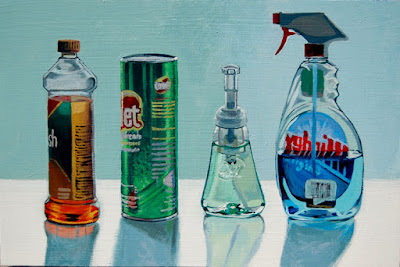

Well, it's actually the same bridge with arches, seen from opposite sides of the Rogue river, at roughly the same time in the day. There is a beautiful park on one of its shores that I've been dying to paint, but the water was calling...We don't have rivers like this in the Bay Area. I painted the purple bridges (18 x 24") on Saturday, and the yellow bridge on Sunday. If you look at the purple bridges, there's a spot by the water between the two, and that's where I sat on the second day to paint the yellow bridge (18 x 18"), on the opposite shore.
To get to the purple side, I parked on 5th St and descended to the water's edge via a steep path that led through some hobo beds. No one bothered me there, but while I was on the opposite shore painting the yellow bridge, a creepy, disheveled man approached from behind quietly. When he was within less than ten feet said, "Nice painting!" out loud. My nerves rattled, I muttered a thank you, and swore to myself I will carry my pepper spray when Kafka is not with me.
Therefore I have penned,
Five Nice Things You Could Say Upon Stumbling Into A Plein Air Painter:
1. Hi, I like to watch artists work. May I look for a couple of minutes?
2. Wow. I don't paint, but I appreciate art.
3. I'm with my kids, would you mind if they get a bit closer to see?
4. Ooops! Are we blocking your view? Please let us know if we are.
5. I'd like to buy your painting when it's done. Do you have a card?
And, Five Mood Killers For Plein Air Painters:
1. How long does it take you to finish? And how much do you sell it for?
2. Whatta wonderful hobby this must be!
3. Are you painting?
4. Shhh. Be quiet, don't you see she's painting?
5. Carol, come over, there's an artist here, PAINTING!
Also, Five Great Conversation Starters To Use On Plein Air Painters:
1. How long have you been painting?
2. Do you have a studio?
3. What drew you to this place?
4. Do you ever use photographs?
5. Do you sell prints of your work?











































